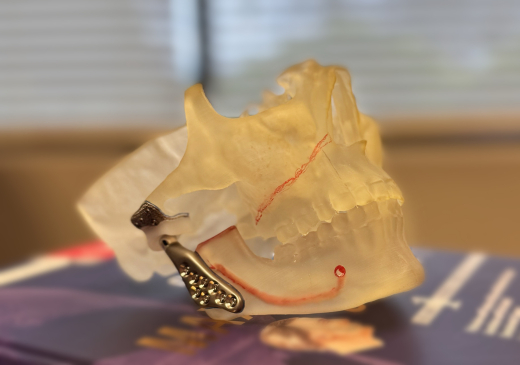
If you experience persistent pain or discomfort in your jaw or if you are unhappy with the shape of your smile, then you deserve to know the facts about orthognathic surgery. Also known as corrective jaw surgery, this procedure can fix and alleviate speech problems, chronic jaw and orofacial pain, under/overbite, obstructive sleep apnea, and many other conditions whose effects range from inconvenient to debilitating.
Who Needs Jaw Surgery?
One third of Americans have significant misalignment of their teeth. This can be caused by birth defects, environmental factors, or facial trauma, but is also simply a consequence of the fact that jaw growth is a gradual process. In some cases, upper and lower jaw bones grow at different rates, leading to asymmetry (for example, the upper jawbone is larger than the lower, or vice versa.) The resultant jaw misalignment may manifest as:
- Severe Underbite: occurs when the lower jaw is larger than the upper jaw, linked with elevated risk of tooth decay and gum disease.
- Severe Overbite: occurs when the upper jaw is larger than the lower jaw, may lead to serious problems with chewing.
- Open Bite: occurs when bottom and top teeth do not touch when the mouth is closed, making it difficult to bite using the front teeth.
In some cases, orthodontia alone can fix these problems. But in other cases, the asymmetry can be more severe, leading to serious symptoms such as difficulty chewing or swallowing; chronic jaw or TMJ pain; and even difficulty with breathing as in sleep apnea. If you experience any of these symptoms, and the misalignment of your jaw is negatively impacting your quality of life, then it’s time to explore the benefits of corrective jaw surgery.
Consulting an Oral Surgeon
Due to the symptoms listed above (or other jaw-related complications), you have decided to explore corrective jaw surgery. Your next step is to consult with an Oral Surgeon or OMS, who will use their expert knowledge of the jaw and face to locate the causes of any pain or discomfort and determine whether surgical intervention is the most advisable path forward. If they do recommend surgery, an OMS will work alongside the rest of your care team, particularly your orthodontist, to prepare you for the procedure. Many patients not only report less pain after such a surgery, but greater confidence in their appearance, leading to overall improvement in their lives. For this reason, an OMS will keep you as informed as possible throughout the process, using facial X-rays and computer-generated facial scans to show what you can expect after the procedure.
Corrective Jaw Surgery: What to Expect
This procedure, performed by your OMS, is usually done under general anesthesia. The surgeon manipulates your jawbone and moves the bones into their new position. They then secure the bone with tiny screws, plates, and rubber bands, which over time are integrated into the bone structure. In other cases, additional bone is taken from elsewhere in the body, such as the hip or ribs, and added to the jaw using screws. Examples of common procedures include:
- Maxillary Osteotomy: This is a surgery done to correct abnormalities in the upper jaw, or maxilla. The OMS adjusts the maxilla or removes excess bone so that it fits properly with the lower jaw, or mandible. This can alleviate problems like overbite, crossbite, open bite, or midfacial hypoplasia.
- Mandibular Osteotomy: This is a surgery done to correct abnormalities in the lower jaw, or mandible. The OMS manipulates the bone behind the molars so that the whole jaw can move as one, aligning the mandible with the maxilla. This can alleviate problems such as receding or protruding lower jaw.
After surgery, there is a recovery period, during which your care team may again use orthodontics to complete the alignment of your jaw. During this time, your doctor may give you instructions such as avoiding strenuous activity, limiting the consumption of solid foods, and taking medications to manage pain. The result, after 6-12 weeks of healing, is your brand-new smile.
The Benefits of Corrective Jaw Surgery
For many people suffering from jaw pain and orofacial discomfort, corrective surgery can be life-changing. After receiving surgery, patients report less pain, less difficulty chewing, breathing, and swallowing, and improved confidence in their appearance. What’s more, corrective jaw surgery can help to treat serious conditions such as sleep apnea, which when left untreated can have life-threatening complications. For a happier, healthier life, talk to an OMS about corrective jaw surgery today.
Back




